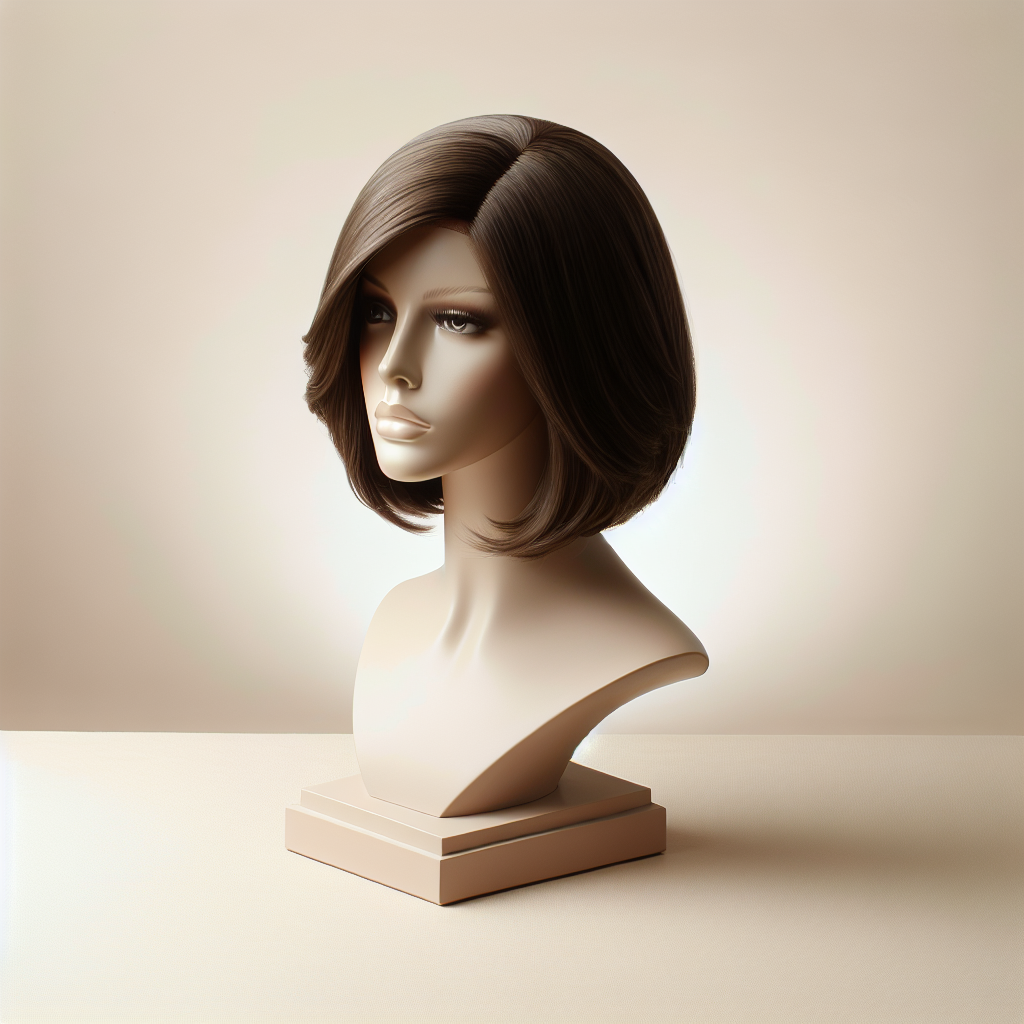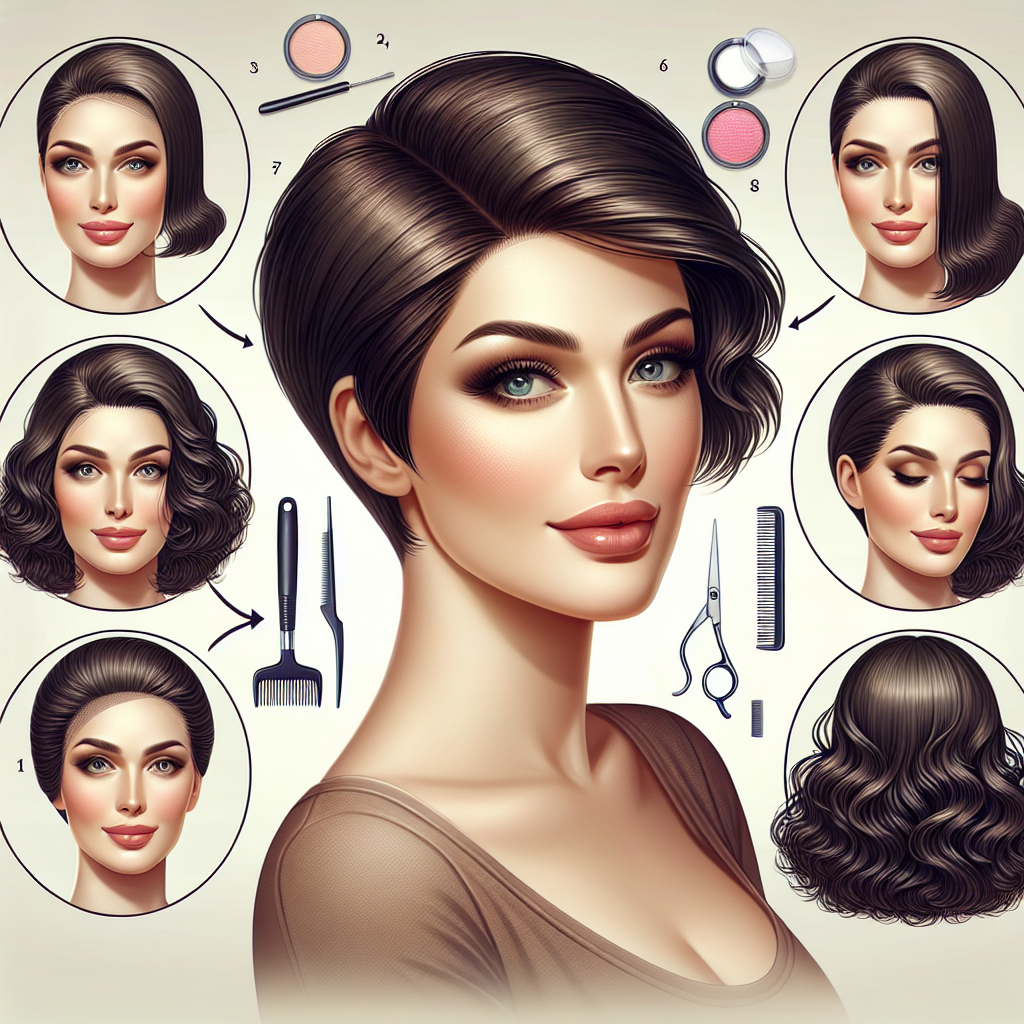You’ve got yourself a fabulous short human hair wig, and now you’re wondering how to style it to perfection. Look no further! In this article, we will guide you through simple steps to effortlessly style your short wig, giving you a stunning and natural look. Whether you’re new to wig styling or a seasoned pro, these tips and tricks will help you transform your wig into a head-turning masterpiece. Get ready to unleash your creativity and embrace the endless possibilities of styling your short human hair wig.

Choosing the Right Wig
When it comes to choosing the right wig, there are a few key factors to consider. One important aspect is the length of the wig. The length of the wig should complement your personal style and preferences. If you prefer a sleek and polished look, you may opt for a shorter wig. On the other hand, if you prefer a more glamorous and voluminous style, a longer wig may be the perfect choice for you. Ultimately, the length of the wig should reflect your individual style and make you feel confident and beautiful.
Another important factor to consider when choosing a wig is the color and texture. The color of the wig should complement your skin tone and enhance your natural features. Whether you prefer a bold and vibrant color or a more subtle and natural shade, there is a wide range of options available to suit every preference. Additionally, the texture of the wig is equally important. Some people prefer a smooth and silky texture, while others may prefer a more textured and voluminous look. It is important to consider your personal style and choose a wig with a texture that suits you best.
Lastly, it is crucial to choose a wig cap that fits snugly. The wig cap is the base of the wig and ensures a secure and comfortable fit. A properly fitting wig cap not only provides stability but also allows for natural movement and prevents the wig from slipping or sliding. When selecting a wig cap, it is important to measure your head size accurately to ensure a perfect fit. Investing in a high-quality wig cap will greatly enhance your overall wig-wearing experience.
Preparing the Wig
Before you start styling your wig, it is essential to properly prepare it. This involves washing and conditioning the wig to maintain its softness and shine. Washing the wig removes any dirt, oil, or product buildup, leaving the wig clean and ready for styling. To wash the wig, you can use a mild shampoo specifically designed for wigs. Gently lather the shampoo into the wig, being careful not to rub or scrub vigorously. Rinse the wig thoroughly with cool water, ensuring that all the shampoo is completely removed.
Once the wig is clean, it is important to condition it to maintain its softness and shine. Using a wig conditioner or a leave-in conditioner specifically formulated for wigs, apply a small amount onto the hair of the wig. Gently comb through the hair with your fingers or a wide-toothed comb to distribute the conditioner evenly. Leave the conditioner on for the recommended amount of time, then rinse thoroughly with cool water. Conditioning the wig will help to keep the hair soft, manageable, and tangle-free.
After conditioning the wig, it is time to detangle the hair. This step is crucial to remove any knots or tangles that may have formed during washing or conditioning. Starting from the ends of the hair, gently comb through using a wide-toothed comb or a wig brush. Work your way up towards the roots, being careful not to pull or yank on the hair. Detangling the wig ensures that the hair is smooth and ready for styling.
Styling Tools and Products
To achieve your desired wig style, it is important to gather the required styling tools. These tools will help you achieve different looks and manipulate the wig to suit your preferences. Some essential styling tools include a wig brush or wide-toothed comb, hair clips or bobby pins, and a variety of styling brushes or rollers depending on the desired hairstyle.
In addition to the right tools, it is essential to select the appropriate hair styling products. This will vary depending on the desired style and the type of wig you have. Some common hair styling products for wigs include wig hairspray, styling gel or mousse, shine serums, and heat protectant sprays. These products will help you achieve different textures, hold the style in place, and protect the hair from damage during heat styling.
If you plan on using heat styling tools such as curling irons, flat irons, or blow dryers, it is crucial to use a heat protectant spray. Heat can damage the hair fibers of the wig, causing them to become dry and brittle. Applying a heat protectant spray before using any heat styling tools helps to minimize damage and keep the wig looking its best.
Basic Styling Techniques
Brushing and combing the wig is a simple yet crucial step in the styling process. Using a wig brush or a wide-toothed comb, gently brush the hair starting from the ends and working your way up towards the roots. This helps to remove any tangles or knots and gives the wig a smooth and polished look. When brushing, be gentle and avoid pulling or yanking on the hair to prevent damage.
To create volume in your wig, teasing or backcombing can be a helpful technique. Using a fine-toothed comb or a teasing brush, gently backcomb small sections of the hair at the roots. This technique adds height and body to the wig, creating a voluminous and glamorous look. Be sure to be gentle when teasing and avoid excessive backcombing, as this can cause damage to the wig fibers.
Defining the parting of the wig is another important aspect of styling. Depending on the style of the wig, you may need to create a distinct parting to achieve your desired look. Using a comb or your fingers, part the hair in the desired direction and style it accordingly. This helps to create a natural and seamless appearance and ensures that the wig complements your overall look.

Straightening Techniques
If you prefer a sleek and straight hairstyle, there are several techniques you can use to achieve this look. Using a flat iron is one of the most common methods for straightening a wig. Start by applying a heat protectant spray to the hair to minimize damage. Then, section the hair and glide the flat iron through small sections at a time, starting from the roots and working your way down to the ends. Ensure that the heat setting is appropriate for your wig and be careful not to keep the flat iron in one place for too long to avoid overheating and damaging the hair.
Blow drying can also help to achieve a smooth and straight look. After washing and conditioning the wig, apply a heat protectant spray and use a round brush to blow dry the hair. Divide the hair into sections and direct the airflow of the blow dryer down the hair shaft, smoothing out any tangles or kinks. Brush through each section as you blow dry to achieve a polished and sleek result.
For a straightened and voluminous look, using rollers can be an effective technique. After washing and conditioning the wig, apply a heat protectant spray and divide the hair into small sections. Wrap each section of hair around a roller, starting from the ends and rolling up towards the roots. Use clips to secure the rollers in place and leave them in for the recommended amount of time. Once the hair is completely dry, remove the rollers and comb through the hair to achieve a straightened and voluminous style.
Curling Techniques
If you prefer to add some curls or waves to your wig, there are several techniques you can use to achieve this look. Using a curling iron is a popular method for creating classic curls. Before curling, apply a heat protectant spray to the hair and divide it into small sections. Wrap each section of hair around the curling iron, holding for a few seconds before releasing. Repeat this process for each section of hair until you have achieved your desired curl pattern. Once all the curls have cooled, gently comb through them with your fingers or a wide-toothed comb to create soft and defined curls.
Another technique for curling a wig is setting it in curlers. After washing and conditioning the wig, apply a heat protectant spray and divide the hair into small sections. Roll each section of hair around a roller, starting from the ends and rolling up towards the roots. Secure the rollers in place with clips and leave them in for the recommended amount of time. Once the hair is completely dry, remove the rollers and gently separate the curls with your fingers or a wide-toothed comb to create defined and bouncy curls.
If you prefer a more relaxed and natural wave, using flexi rods can achieve this look. After washing and conditioning the wig, apply a heat protectant spray and divide the hair into small sections. Wrap each section of hair around a flexi rod, starting from the roots and rolling it up towards the ends. Bend the ends of the flexi rod to secure it in place. Leave the flexi rods in overnight or for the recommended amount of time to allow the hair to set. Once the hair is completely dry, remove the flexi rods and gently separate the waves with your fingers or a wide-toothed comb for a bouncy and voluminous wave effect.

Creating Texture and Body
To add texture and body to your wig, there are a few techniques and products that can help you achieve this look. Applying mousse to the hair is a great way to create texture and add volume. After washing and conditioning the wig, apply a small amount of mousse to your hands and scrunch it into the hair from the roots to the ends. This creates texture and gives the wig a fuller and more voluminous appearance. Avoid applying too much mousse, as this can weigh down the hair and make it appear greasy.
Using a texturizing spray is another effective method for adding volume to your wig. After washing and conditioning the wig, apply the texturizing spray to the roots of the hair and gently massage it into the scalp. This lifts the hair at the roots and adds body and volume to the wig. You can also use your fingers or a wide-toothed comb to lightly tease the hair at the roots for added texture and body.
If you want to take your wig styling to the next level, teasing or backcombing the hair can provide extra body and volume. Using a fine-toothed comb or a teasing brush, gently backcomb small sections of the hair at the roots. This technique adds height and body to the wig, creating a voluminous and glamorous look. Remember to be gentle when teasing and avoid excessive backcombing to prevent damage to the wig fibers.
Adding Accessories
Adding accessories to your wig can elevate your style and make it more personalized. Headbands and scarves are popular options for accessorizing wigs. They can add a pop of color, create different looks, and keep the hair away from your face. Whether you prefer a wide headband, a thin scarf, or a bold print, there are endless options to choose from. Experiment with different styles and colors to find the look that suits you best.
If you want to change up your look without committing to a new hairstyle, clip-in bangs or fringes can be a great option. These versatile accessories instantly transform your wig, allowing you to experiment with different looks and face-framing styles. Clip-in bangs or fringes come in a variety of colors and styles, making it easy to find the perfect match for your wig and personal style.
Decorative hairpins and barrettes are another way to accessorize your wig. They can add a touch of elegance and sparkle to your hairstyle. Whether you prefer a classic and understated look or a bold and statement-making style, decorative hairpins and barrettes come in a variety of designs and colors to suit every occasion and preference. Experiment with different placements and arrangements to create unique and eye-catching hairstyles.

Fixing the Style in Place
Once you have achieved your desired wig style, it is important to fix it in place to ensure that it lasts throughout the day. Using hairspray is a common method for holding a style in place. Hold the hairspray about 12 inches away from the wig and mist it evenly over the hair. Be sure to use a wig-friendly hairspray that won’t weigh down or damage the hair fibers. This will help to maintain the style and ensure that it does not lose its shape or volume.
Bobby pins can also be used to secure the wig in place and prevent it from shifting or moving throughout the day. Simply slide the bobby pins into the wig cap, anchoring the wig to your natural hair or scalp. This provides added security and stability, ensuring that the wig stays in place and maintains its desired style. Be sure to use bobby pins that closely match the color of your wig for a seamless and natural look.
In some cases, you may need to use wig tape or glue to secure the wig in place. This is especially true for wigs with lace fronts or full lace wigs. Wig tape or glue can be applied along the hairline to create a secure and natural-looking attachment. It is important to follow the manufacturer’s instructions and guidelines when using wig tape or glue to ensure proper application and removal. This will ensure that your wig stays in place and looks seamless and natural.
Caring for Your Styled Wig
After styling your wig, it is important to maintain it properly to ensure its longevity and keep it looking its best. Establishing a daily wig care routine is essential for keeping the wig clean, fresh, and ready for styling. This routine may include brushing or combing the wig, applying styling products, and storing it properly when not in use. By incorporating these steps into your daily routine, your wig will stay in great condition and continue to look beautiful and vibrant.
During sleep, it is important to protect the wig to prevent tangling or damage. Using a satin or silk sleep cap or pillowcase can help to reduce friction and keep the wig in place while minimizing tangling. Alternatively, you can gently braid or twist the hair of the wig before sleeping to prevent it from tangling and becoming unruly. Taking these precautions will ensure that your wig stays in great condition and is ready to be styled in the morning.
When storing your wig, it is important to do so properly to maintain its shape and prevent any damage. The ideal method for storing a wig is to place it on a wig stand or mannequin head. This helps to preserve the style and shape of the wig and prevents it from becoming tangled or flattened. If a wig stand or mannequin head is not available, you can also store the wig in a clean and dry box or bag specifically designed for wig storage. Be sure to gently comb or brush the wig before storing to ensure that it is free from tangles and knots.
In conclusion, styling a short human hair wig can be a fun and rewarding process. By following the steps outlined in this article and considering factors such as wig length, color, and texture, you can achieve the perfect look for any occasion. Preparing the wig by washing, conditioning, and detangling it is essential to ensure a smooth styling process. Additionally, choosing the right styling tools and products, such as brushes, rollers, and heat protectants, will help you achieve your desired hairstyle. Whether you prefer a straight, curled, or textured look, there are various techniques you can use to achieve your desired style. Don’t forget to accessorize your wig with headbands, scarves, clip-in bangs, or decorative hairpins to enhance your overall look. Lastly, caring for your styled wig by following a daily care routine, protecting it during sleep, and storing it properly will ensure its longevity and keep it looking its best. With the right techniques and a little creativity, you can confidently rock your styled wig and enjoy the versatile world of wig styling.

